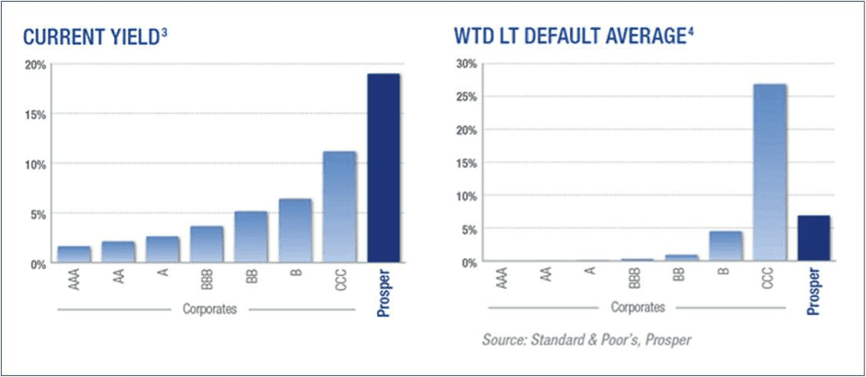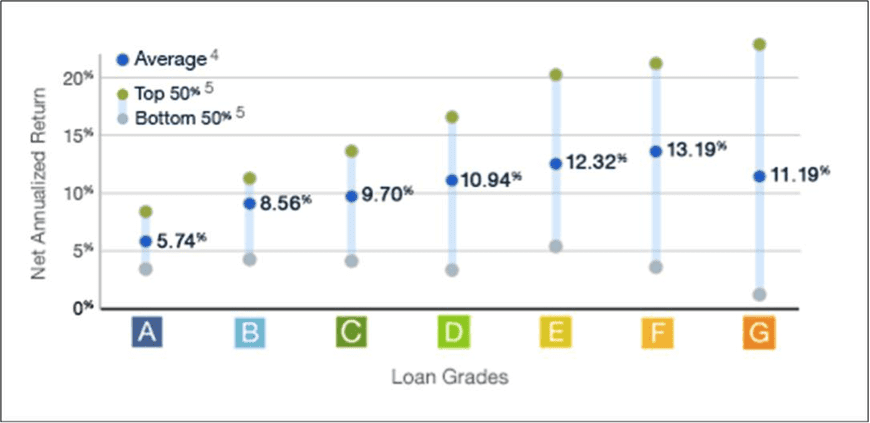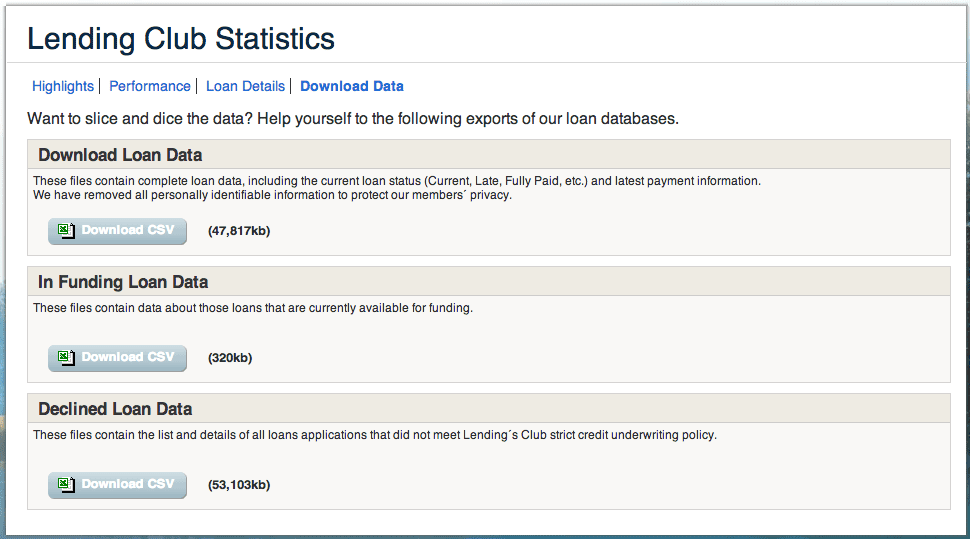This is a guest post from reader Josh Brooks. Josh enjoys talking about, studying, and investing in consumer debt notes. Between three accounts at Lending Club (9, 15, and 20 months old), he has personally hand-picked more than 4,000 consumer debt notes, and currently enjoys net annualized return of more than 16 percent in each account. You can reach Josh at 24jbrooks@gmail.com.
After much study and practical experience, I have concluded that consumer debt notes are the best investment available to small and retail investors, in terms of volatility elimination, risk reduction, and return on investment. Four points articulate my rationale:
- The absence of volatility associated with investing in consumer debt notes is highly desirable, in terms of both maximizing rate of return, as well as managing the stress and anxiety of risking capital.
- When compared to the risk-return characteristics of some conventionally-accepted investments, it becomes obvious that consumer debt notes are the investment that offers the best return for the lowest risk.
- With a little internet skill, anyone can build a diversified portfolio of consumer debt notes that enjoys double digit returns.
- With a little more internet skill and some investing savvy, an investor can build a portfolio of diversified consumer debt notes that enjoys remarkable double digit returns.
The S&P 500 Compound Annual Growth Rates
To expand on these four points, I offer the following four figures and commentary, for your review and consideration.
Figure 1: S&P 500 CAGR for 5, 10, 15, and 20 Years.
(https://www.moneychimp.com/features/market_cagr.htm)
Figure 1 shows the S&P 500 Compound Annual Growth Rates (CAGRs) for different intervals during the last 20 years. Knowing what the stock market’s CAGR is and understanding what the CAGR represents does two things for us.
First, it provides us an average rate of return which we can use to compare to other investments. For example, the worst-performing of my three Lending Club accounts enjoys a net annualized return of more than 16.00%. Compare this to the best CAGR available in Figure 1 (7.82%), and it becomes easy to see why I have moved away from equities, toward consumer debt notes.
[Editor’s note: It is important to remember that your Lending Club NAR may not reflect your real return. It is always useful to calculate your actual return on your p2p lending investments and not just rely on what Lending Club or Prosper tells you.]
Second, knowing and understanding the CAGR demonstrates the adverse effects of down years and market volatility on rate of return. For mid- and long-term investors, down years and volatility are inherent elements of stock market investing. Not only are these two elements very bad for a stock portfolio rate of return, but they can also be stressful to endure. For example, after working so hard for their money, what investor likes to see an annual loss of 11.89% (2001), 22.10% (2002), or 37.00% (2008)? Similarly, how emotionally and psychologically wearing is it to watch the stock market (and the value of an equities-based investment) bounce around, up and down, based on news and events that are most of the time completely unrelated to the equities held? I do not enjoy either of these experiences. As Figure 1 demonstrates, such events wreak havoc on the rate of return of an equities-based investment, and thus make the double-digit return possible with peer-to-peer lending a compelling alternative.
Along with Money Chimp, Investing Answers has an excellent CAGR calculator, which I use to experiment and learn more about the CAGR.
Comparing Prosper Notes to Corporate Bonds
Figure 2: Yield and Default Rates of Corporate Bonds and Prosper Notes
(https://blog.prosper.com/2012/09/17/august-2012-investor-monthly-update/)
I took Figure 2 from Prosper’s investor monthly update for August 2012. As you can see, the yield of Prosper’s consumer debt notes is superior to high-yield corporate bonds by approximately seven percent. Because yield (return) is much higher, it makes sense that default rate (risk) would be much higher as well, right? Not so. When compared to corporate bonds, Prosper’s consumer debt notes experience a default rate that is more comparable to B grade corporate bonds, despite offering a rate of return that dramatically exceeds even CCC grade bonds.
Based on what Figure 2 depicts, the risk/return characteristics of consumer debt notes are out of balance in the retail/small investor’s favor when compared to corporate bonds. To say this another way: with consumer debt notes, I can enjoy a superior return with far less risk than if I were to invest in corporate bonds or bond-based mutual funds. Ask any competent financial advisor, and they will tell you that managing risk is one of the most important – if not the most important – aspect of a long-term wealth creation and preservation plan.
High Interest Notes at Lending Club
Figure 3: Lending Club Net Annualized Return
(https://www.lendingclub.com/public/steady-returns.action)
The blue dots in Figure 3 depict the average net annualized return of Lending Club consumer debt notes by grade of loan. This is an approximate rate of return that an investor can expect on a properly diversified portfolio of notes in that grade, after defaults.
As you can see, even with no critical analysis or filtration, a retail/small investor can easily earn double-digit returns (again, after defaults) by investing in lower-grade notes. For example, when browsing for notes, I use Lending Club’s filter tool to limit my browsing to only those notes rated D5 through G5. This shows me consumer debt notes that will pay 19.72% to 24.89% interest, which with a default rate of approximately 6.25% (for D5 grade notes) to approximately 10.50% (for G5 grade notes), should net me a pre-tax rate of return from 13.47% to 14.93%. If you have a diversified, repeatable investment that is performing at this level (or better), please feel free to share it with me.
Analyzing the Lending Club Data
Figure 4: Lending Club Statistics
(https://www.lendingclub.com/info/download-data.action)
Figure 4 shows the statistics page on Lending Club’s Web site. Talk about transparency: the complete loan data file allows any investor to download a sanitized (no personally-identifiable information), detailed list of every loan funded. Does any debt or equity investment you have provide this level of transparency?
Using the filtration and sorting functions in Microsoft Excel, we can work this data to identify those loan characteristics which might indicate or predict a higher default rate, and then create browsing filters to exclude these loans with these negative characteristics when we invest. By doing this, we can design a filter that further reduces the risk of default, which can result in an increase of return above 15.00% (pre-tax).
For example, my recent analysis of loan purpose using Lending Club’s CSV file revealed that small business loans have a ‘bad note’ (default, charged off, late 31-120, or payment plan) rate of 17.43%, for 60 month notes, grades D5 through G5. In contrast, notes with the loan purposes of debt consolidation and credit card refinance have ‘bad note’ rates of 8.74% and 5.59% respectively. Based on this analysis, if I avoid notes with the loan purpose of small business, I will experience less defaults (on both an absolute basis, as well as compared to Lending Club’s loss rate models), and thus enjoy an increased rate of return.
Does this work? For me, the proof is in the pudding: I currently manage three Lending Club accounts, and by applying this methodology (along with other risk reduction and return-enhancing techniques), I have been able to enjoy net annualized returns that are currently more than 16.30%, 17.70%, and 18.50%. It is important to note that my accounts are still young (9, 15, and 20 months old), but so far, by employing this risk management, the net annualized return I enjoy is increasing (as a result of picking better, higher rate notes), instead of decreasing (as a result of defaulting notes eating into my rate of return).
In summary, investing in consumer debt notes enables me to eliminate volatility, minimize risk, and maximize return on my money invested. I am constantly on the lookout for a better investment, and when compared with what else is available to the small and retail investor, consumer debt notes are the best option for me.





